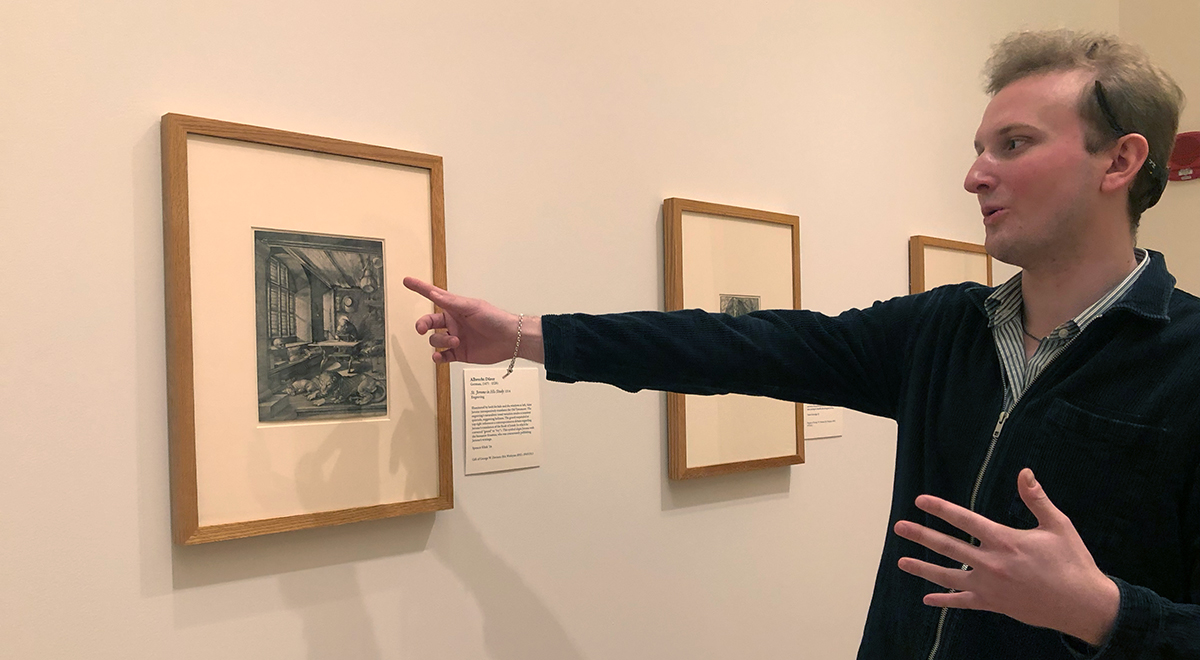Students Research Works in Davison Art Collection for New Print Exhibition

The exhibition “Dürer and His Time,” on display at the new Pruzan Art Center, is an example of a Wesleyan art education at work.
Students in the course “Curatorial Workshop: The Northern Renaissance Print” examined prints in the Davison Art Collection from a pivotal moment in Western tradition in order to pull together the exhibition. It’s a curation of works by renowned German painter and printmaker Albrecht Dürer (1471-1528) and select artists from the collection. Assistant Professor of Art History and Medieval Studies Joseph Salvatore Ackley, who teaches the course, guided the student’s research, while Miya Tokumitsu, the Donald T. Fallati and Ruth E. Pachman curator of the Davison Art Collection, helped the students explore the works and assemble the exhibition.
“Dürer and His Time” is on display in the Pruzan Art Center through Saturday May 25.
New Art Space Enriches Student Experience
Ackley, a member of the Wesleyan faculty since 2019, introduced the course during the spring 2024 semester. “This seemed like an interesting idea and an interesting opportunity,” he said, adding that one of the strengths of the Davison Art Collection are prints from the period of time that he focuses on teaching. “I’m feeling very fortunate. It’s just such a pleasure and a privilege to be able to work with original works of art.”
Tokumitsu, who featured student-curated projects at the previous gallery location on campus in September 2019, said the Pruzan Art Center’s learning gallery, and the Davison Art Collection’s new, larger study room, give students more of the space needed to work with the art. “It is definitely a wonderful enhancement to the experience,” Tokumitsu said. “It’s really moving to see how engaged the students are.”
Ackley said he is thrilled with the new resources the center provides for students and faculty in the Art History Program. He called the birth of the stand-alone fine art print a radical new art form. “Through these works, we are able to offer this exciting slice of what that looked like in a thorough and meaningful way,” Ackley said.
Ackley and Tokumitsu selected 13 works over winter break, and the 12 students in the workshop examined the works, along with other works from the collection, over the first half of the semester. “They’re learning how to do print-specific scholarship,” Tokumitsu said of the students, who learned the behind-the-scenes process of how an exhibition comes together, including presenting a layout and writing the wall labels that visitors view in the gallery. For the wall labels, Tokumitsu asked the students to consider what the audience might want to know if they had no context for the prints.
“The research continues throughout the semester,” Ackley said of students, who are developing research projects related to the objects, exploring the themes of the exhibition including Christian devotion and classical mythology, and presenting to the class.
Opportunity to Apply Theory to Pragmatic Goals
Spencer Klink ’24 is one of the students in the curatorial workshop who set up the exhibition. “It’s been a really amazing educational and creative experience,” Klink said. “To be a part of one of its early exhibitions is truly an honor.” For the exhibition, he researched Dürer’s engraving “St. Jerome in His Study” (1514).
Originally from Los Angeles, Klink is a double major in Art History and Art Studio with a printmaking concentration, which has changed the way that he thinks about his own artistic practice. Adjunct Assistant Professor of Art and Art Studio Technician Kate Ten Eyck had suggested Klink try printmaking, so he took classes with Assistant Professor of Art Tammy Nguyen. Those classes frequently visited the Davison Art Collection to study prints. “Printmaking has become my passion,” Klink said. “I’m very interested in establishing conceptual linkages and engaging with whatever I’m doing in an interdisciplinary way, and I think Wesleyan is a wonderful place for that.”
With Noah Shacknai ’25, Klink organized the t-shirt screen-printing activity in the Print Workshop at the 50th birthday party for the Center for the Arts in September 2023.
And in his own artworks, “🌈🏙🚇😍 (Rainbow City Subway Love)” in the Senior Thesis Exhibitions in the Ezra and Cecile Zilkha Gallery this spring, Klink developed his own abstract visual language of 500 different mosaiced prints, constructing dynamic compositions that reflect on experiences he’s had while at Wesleyan, including travels to New York, and Berlin, Germany with a grant from the German Studies Department to study abroad.
“I think that’s one of my favorite places that I’ve been on campus,” Klink said of the Davison Art Collection. “I’m trying to really get the most use out of it while I’m here.”
The Davison Art Collection holds more than 25,000 works of art on paper, including prints, photographs, and drawings. The print collection is one of the foremost at a college or university in the United States. The collection supports teaching and learning in many ways, and was established at Wesleyan University with the founding gifts of George Willets Davison, class of 1892.

